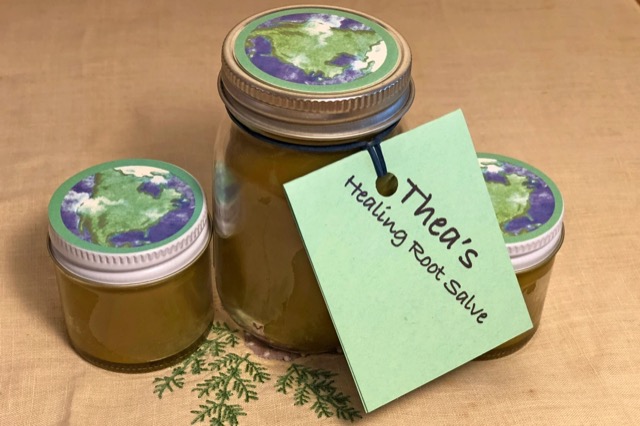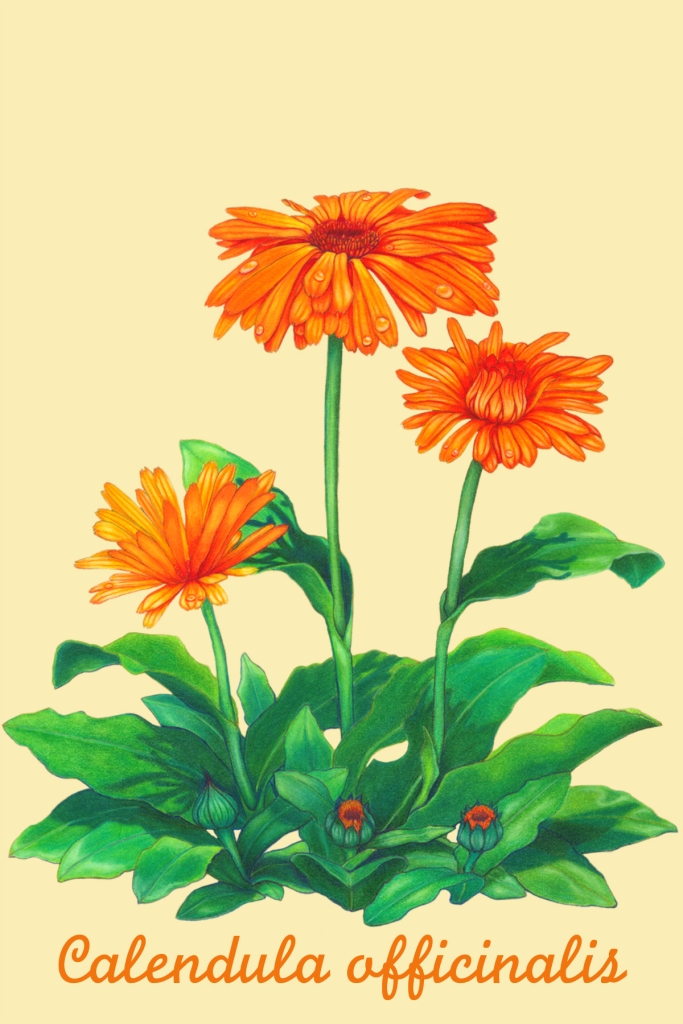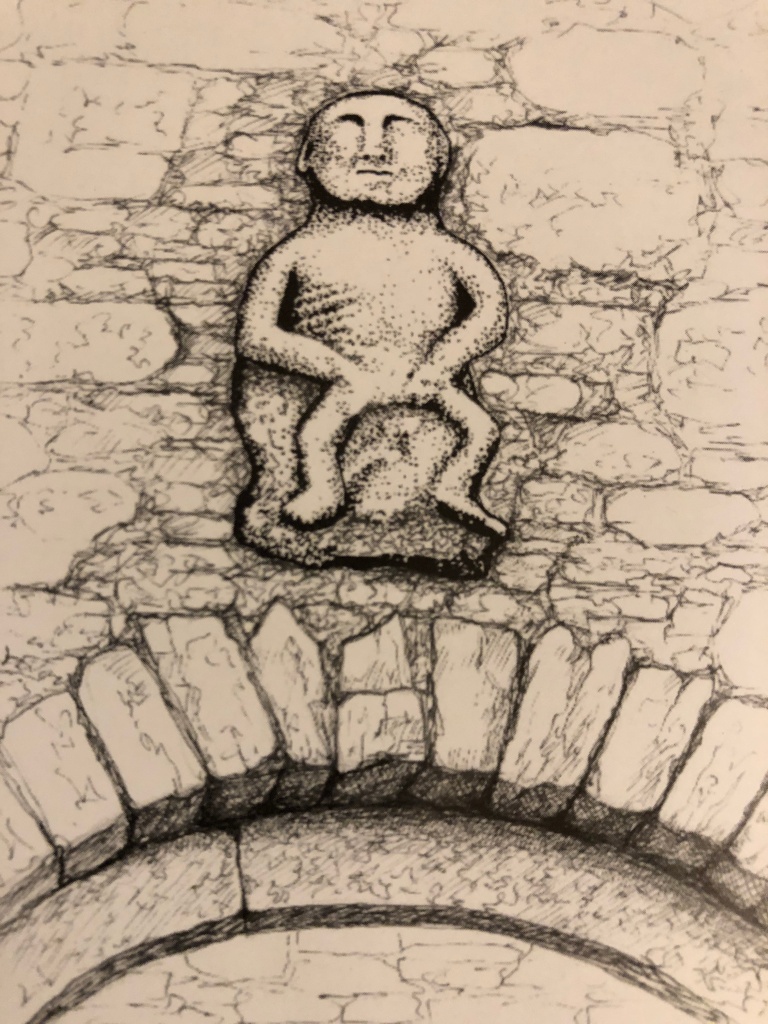
for Healing Power of Herbal Salves with Thea Summer Deer & Susun Weed
November 16th, 2023 @ 9PM Eastern ~ Replay Available
I moved during the unseasonably sweltering summer heat of 2023 from the verdant blue-green mountains of Western North Carolina, where I had lived for 25 years, back to the high desert. The first time I moved to the desert 34 years ago, it took about a year for my skin to adjust to the dryness that caused my hands to crack and bleed. Someone at the local feed store recommended Cornhuskers lotion, which gave relief, but this time, I came prepared with something better: the healing power of herbal salves.
The collection of salves that fill my medicine cabinet includes calendula for tissue damage and swellings, comfrey and goldenseal for wound healing, pine tar for drawing out splinters, chaparral for sun damage, lavender for calming insect bites, stings, and burns, plantain for skin healing, and wild yam and vitex for thinning skin. Some were made by me or by friends, and some I buy. Nature gives us Band-Aids, balms, antiseptics, and wound-healing action in the form of herbal salves. No medicine chest should be without them. They work because it is nature’s goal to make us whole. I want to share some of those salves with you, how I make them, the ones I buy, their herbal actions, and personal stories about their healing medicine.
I began making salves 45 years ago as a midwife, and it all started with comfrey when Susun Weed taught us how to prepare leaf infusions to be used in a sitz bath or as a compress to heal perineal tears, abrasions, and episiotomies. Long used to heal damaged skin, comfrey worked like a miracle. The plant is easy to grow and propagate, so I began growing it in my garden. With two toddlers at home banging their knees, skinning elbows, or otherwise collecting scratches, bumps, bug bites, and bruises as they explored their world, I decided to make a healing salve using the two main ingredients I used in my postpartum sitz baths – comfrey and goldenseal. The result was a salve that prevented infection, reduced scarring, and healed wounds quickly. I have been making it ever since (recipe below.)
One crucial herb I learned about years ago when I lived in the Sonoran desert is chaparral (Larrea tridentate). Medicine man Willie Whitefeather initially introduced me to the plant, a shrub native to southern areas of the U.S. and northern regions of Mexico. Chaparral is also known as creosote bush and greasewood. Whitefeather used the anti-tumor action of this herb to heal certain skin cancers in himself and others.
Recently, I developed a painful skin growth before leaving the Appalachian mountains of North Carolina for the Piños Altos mountains of New Mexico. As timing would have it, the move eclipsed my yearly dermatological exam. I couldn’t get another appointment for three months. Meanwhile, the growth darkened and continued to get worse. I couldn’t afford to wait. I needed to make a chaparral salve. Fortunately, there is an abundance of chaparral in the desert, and it is no accident that nature grows the remedy for sun damage and skin cancers in a state that boasts 310 days of sunshine annually. At the local co-op, I found a product line called Desert Woman Botanicals, and lo and behold, they had a chaparral salve as good as any I would make. The skin growth fell off within weeks, and the sore beneath disappeared. I have shared a list of companies below whose salves I recommend.
After returning to the desert, I began clearing the overgrowth in my yard and trimming the trees. While lopping a juniper branch, I sustained a nasty cut that drew blood. Because it was deep and the tree sap toxic, I used Piñon salve, known as trementina in the Southwest. I call it nature’s bandaid. Piñon salve draws out toxins and protects the skin. And it helps wounds heal due to its antiseptic and anti-inflammatory actions. If I had offended the juniper, perhaps the pine would redeem me. Piñon pine resin is considered sacred by the Native Americans who use it.

from Wisdom of the Plant Devas: Herbal Medicine for a New Earth
Another healing herb I learned about when my babies were in diapers is calendula (Calendula officinalis). A popular go-to for eczema, calendula cremes and ointments were indispensable for diaper rash and sore nipples. Once, I tried using calendula flowers in a salve for a ganglion cyst on my wrist. Calendula is known to reduce inflammation and swellings and to heal cysts with its anti-inflammatory, lymphatic, and astringent action with an affinity for the skin. To my amazement and with consistent application, the cyst dissolved within a month. Calendula flowers lend themselves well to many herbal salve formulas and contain antifungal and antibacterial actions that help burns, bruises, and cuts heal faster and prevent the minor infections they cause.
Herbal salves are particularly useful for pets, and I have used them with mine and other people’s animals for decades. Pets tend to be more agreeable to application because the ingredients are natural and of food-grade quality. And if they lick, they are getting the medicine internally, and it won’t hurt them. Keep reapplying and trust your animal to heal.
There are too many herbal salves to mention in one article, but I always keep a plantain salve on hand because of its versatility and wide range of herbal actions (see below). Plantain is plentiful, easy to gather, and can be used fresh or dried. And because we are mostly women here, there is one more salve that bears mentioning and which I have relied on for support “down there” since becoming post-menopausal. MoonMaid Botanicals makes a wild yam and vitex salve called Vital “V,” V meaning vulva. Sheela Na Gig knows the importance of a happy vulva!

Making a Salve:
Salves are traditionally made in a 1:4 ratio of beeswax to oil and have more beeswax than a balm. The beeswax acts as a preservative and helps hold the herbal-infused oil on the skin for a more extended time, allowing its medicinal properties to penetrate more deeply. Adding beeswax makes it more effective than putting the oil directly onto your skin. Body heat activates the salve so it melts into the skin. An herbal salve is more concentrated and medicinal than a lotion because the water in a lotion requires an emulsifier. Salves do not contain water and are considered an anhydrous formulation.
A salve is made from an herbal oil, using fresh or dried herbs steeped in vegetable oil. The extraction of medicinal compounds requires gentle heat. Gums and resins are highly soluble in oil. Alkaloids, mucilage, and other constituents are partially soluble in oil. Using only the purest vegetable oil is critically important to avoid extracting agricultural chemicals. I recommend using certified organic olive, sesame, jojoba, almond, or coconut oil. Certain herbs are best when used dried. Drying breaks down the plant’s cell wall, making the constituents more readily available for extraction. Other herbs are best used fresh and must be bruised or chopped before adding to the oil. Making Plant Medicine by Richo Cech is a good resource for knowing which herbs extract well in oil, what plant parts to use, and whether the plants are best used fresh or dried.
Basic Salve recipe
1:3 – fresh herb weight to oil volume. For example: 100 grams fresh plant material/300 ml oil
1:5 – dry herb weight to oil volume. For example: 100 grams dried plant material/500 ml oil
100:17 – volume of herbal oil to golden beeswax in grams. Approximately 1 oz of wax per cup of oil.
Prepare the plant material (dried, cut, sifted, powdered, etc.), measure it, and place it in an uncovered crockpot, oven-safe enamel, or glass bowl. Cover with oil and mix thoroughly with a wooden spoon. Maintain the mixture at a low temperature over time. Generally, 170º (the lowest preset temperature on most ovens) for four hours, stirring every half hour. Leave the oven door slightly open if your range runs hot or the mixture is boiling.
If your oven runs hot or the mixture is boiling, leave the oven door slightly open.
Pour the infused oil through several cheesecloth layers or cotton muslin cloth into a bowl or pan to separate the spent herbs from the oil infusion, squeezing and pressing the herb to express as much oil as possible. Pour the oil into a clean, dry jar. Cover and let stand overnight so that particulate matter settles. Pour the clear oil off the top, leaving the sludge behind at the bottom of the jar. Use immediately or store in amber glass bottles in a cool, dark place. The expected shelf life is about a year.
Pour measured oil into a saucepan, add beeswax, and slowly melt the beeswax on low heat and stir with a wooden spoon. Be sure to have your dry, clean jars ready. Immediately remove from the heat once the wax melts, and carefully fill the jars using a pan or Pyrex beaker with a spout. Clean your pans and utensils while still warm by wiping them with a paper towel. Store in a dark, cool place. Salve has an expected shelf life of 3 years.
Note: Golden beeswax is a preservative and is superior to paraffin, derived from petroleum. You can buy it by the block, shave it yourself, or purchase golden beeswax beads.
Thea’s Healing Root Salve
What makes this salve different than most comfrey-goldenseal salves you will find on the market is the quantity of goldenseal (Hydrastis canadensis) root powder in the recipe. Because goldenseal is very expensive, now over $200 a pound, most herbalists and manufacturers use goldenseal leaf instead and minimal root. The quantity of goldenseal root and its anti-microbial and anti-inflammatory action make it effective.
I also use comfrey leaf and root in my formula for their healing benefits. Comfrey root may contain 8-10% allantoin, easily absorbed through the skin and found to a lesser degree in the leaves. Allantoin promotes cell growth to speed wound healing. Comfrey leaf also aids in healing mucous membranes and protects the skin against irritants, making it an essential ingredient in salve. I have used this salve personally and with my clients for wounds, burns, bruises, cuts, sprains, chapped lips, dry vagina, cold sores, diaper rash, bug bites, nail fungus, and skin irritants.

Ingredients (preferably organic):
3 ¼ cups cold-pressed olive oil
¾ cup unrefined sesame oil (high in vitamin E, acts as a skin healer and as a preservative)
2 oz. comfrey leaf
2 oz. comfrey root, cut and sifted
2 oz. goldenseal root powder
golden beeswax beads, approximately 3-4 oz.
1 tablespoon vitamin E oil, or wheatgerm oil (acts as a skin healer and preservative)
Bake in a warm oven (lowest setting possible, approximately 170º) in a glass or enamel pot for 4 hours, stirring with a wooden spoon every 30 minutes. Strain through a fine cheesecloth, pressing the remaining plant material to extract all the oil into a measuring cup. Measure and return oil to clean pot on stove top. Add beeswax (1 oz. per cup) and stir on low heat until melted. Ad wheatgerm or vitamin E oil, stir well and remove from heat. Immediately fill containers as it will harden quickly upon cooling. Stir once while in container with a wooden chopstick to redistribute ingredients and prevent settling.
Actions of herbs used in salve making:
- Calendula: anti-inflammatory, vulnerary, lymphatic
- Chaparral: antiseptic, anti-tumor, antioxidant
- Comfrey: demulcent, vulnerary
- Goldenseal: anti-microbial, astringent
- Lavender: antioxidant, anti-inflammatory, antimicrobial
- Pine sap: antiseptic, antimicrobial, antioxidant, astringent, antifungal
- Plantain: vulnerary, demulcent, anti-inflammatory, astringent, anti-microbial
Recommended Products:
The Super Salve Co. (Calendula)
Desert Woman (Chaparral)
Moon Maid Botanicals (Vital “V” )
Living Earth Botanicals/SOMA Naturals (Calendula oil)
Medicine of the People (Piñon Sap Salve)
Learn more:
The internal and external uses of comfrey
How to make a Piñon salve
Comfrey: How to Use Medicinally as Oil & Salve, by Corinna Wood
Wisdom of the Plant Devas: Herbal Medicine for a New Earth by Thea Summer Deer
Down There: Sexual and Reproductive Health by Susun Weed
Thank you for sharing your knowledge Thea. Very informative!
LikeLike